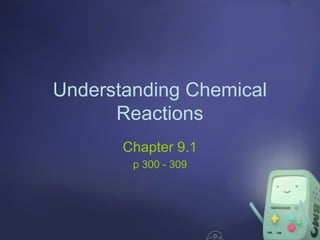Chapter 9.1: Understand Chemical Reactions
This document discusses chemical reactions and how to write balanced chemical equations. It defines physical and chemical changes, and notes that chemical changes result in new substances being formed. A chemical reaction is described as the rearrangement of atoms when bonds break and form. Signs that a chemical reaction occurred include changes in properties, energy, color, odor, state of matter. Chemical equations use symbols to represent elements and formulas for compounds. They show the reactants on the left and products on the right. For an equation to be balanced, the number of atoms of each element must be the same on both sides. The document explains how to identify the reactants and products and balance chemical equations by adding coefficients in front of the formulas and symbols.

Recommended
Recommended
More Related Content
What's hot
What's hot (20)
Similar to Chapter 9.1: Understand Chemical Reactions
Similar to Chapter 9.1: Understand Chemical Reactions (20)
More from Korrnell Academy: L Class Grade 8 Science
More from Korrnell Academy: L Class Grade 8 Science (20)
Recently uploaded
Recently uploaded (20)
Chapter 9.1: Understand Chemical Reactions
- 1. Understanding Chemical Reactions Chapter 9.1 p 300 - 309
- 2. Changes is Matter • Physical Changes • Chemical Changes – Does not produce new substances. – Might have different physical properties – Changes in states of matter: solid, liquid, gas – One or more substances change into new substances – Have different physical and chemical properties. – Cooking is an example of chemical change.
- 3. Chemical Reactions • Chemical changes are called chemical reactions • A chemical reaction is a process in which atoms of one or more substances rearrange to form one or more new substances.
- 4. Signs of a Chemical Reaction • Changes in the physical properties of color, state of matter, and odor are all signs that a chemical reaction might have occurred • A change is energy is another sign.
- 5. Signs of a Chemical Reaction • Change in Properties • Change in Energy – Warming or cooling – Release of light – Color – Odor – Formation of bubbles – Formation of a precipitate * A precipitate is a solid that forms from a reaction between two liquids
- 6. What happens in a chemical reaction? • Atoms rearrange to form new substances – There are 2 types of substances: Elements and Compounds – Substances have a fixed arrangement of atoms – A drop of water each water molecule will have one oxygen atom bonded to two hydrogen atoms – If this arrangement changes the substance is no longer water and a different substance has formed – The new substance will have different chemical and physical properties – This is what happens during a chemical reaction
- 7. Chemical Reactions • Bonds break and bonds form – Atoms rearrange when chemical bonds between the atoms break – Particles are moving in all substances, even solids – These particles collide with one another. – If particles collide with enough energy, the bonds between the atoms can break, separate, rearrange, and form new bonds.
- 9. Chemical Equations • A chemical equation is a description of a reaction using element symbols and chemical formulas • Element symbols represent elements • Chemical formulas represent compounds
- 10. Elemental Symbols • Each element can exist as just one atom – C = carbon Cu = Copper • Some elements exist in nature as diatomic molecules – two atoms of the same element bonded together. – This is shown by a subscript 2 – H2 = hydrogen O2 = oxygen
- 11. Chemical Formulas • A chemical formulas uses elements’ symbols and subscripts to describe the number of atoms in a compound • If an element does not have a subscript, the compound contains only one atom of that element Balanced: 2Na + Cl2 => 2NaCl
- 12. Writing Chemical Equations • A chemical equation included both the substances that react and the substances that are formed in a chemical equation. • The starting substances in a chemical reaction are the reactants • The substances produced by the chemical reaction are products • The arrow shows the direction of the reaction • Reactants are written left of the arrow and products are written to the right
- 13. Conservation of Mass • French chemist Antoine Lavoisier found that the total mass of the reactants always equaled the total mass of the products. • This is the law of conservation of mass, which states that the total mass of reactants before the reaction must equal the total mass of products after the chemical equation.
- 14. Atoms are conserved • Mass is conserved because atoms are conserved • Bonds break and new bonds form during a chemical reaction • However, atoms are neither created, nor destroyed
- 15. Is an equation balanced? • An equation is written so that the number of atoms of each element is the same, or balanced, on each side of the arrow Reactants Conservation of mass Products Conservation of atoms
- 16. Make it balanced! Reactants Elements Products 4 2 H 4 2 2 O 2 1 4H 2 2 2O 4 H, 2 O • Add Coefficients! • A coefficient is a number placed in front of an element symbol or chemical formula in an equation. • Only coefficients can be changed when balancing an equation. • Changing subscripts changes the identities of the substances that are in the reaction.
- 18. Balancing a Chemical Equation 1. Write the unbalanced equation. 2. Count atom of each element in the reactants and in the products. 3. Add coefficients to balance the atoms. 4. Write the balanced chemical equation.
- 19. Balance • ____ N2 + ____ H2 → ____ NH3 • ____ Al + ____ HCl → ____ AlCl3 + ____ H2 (g)
- 20. Lighting a Candle • Lab
